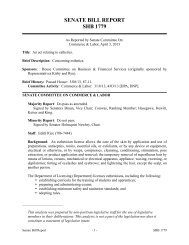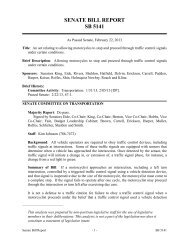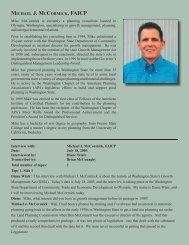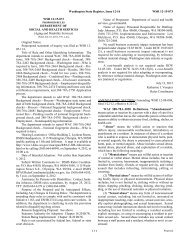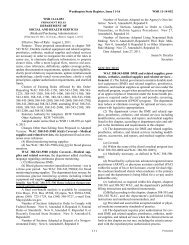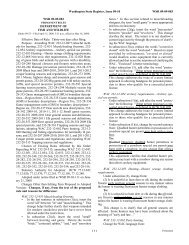Proposed
Proposed
Proposed
You also want an ePaper? Increase the reach of your titles
YUMPU automatically turns print PDFs into web optimized ePapers that Google loves.
the second quarter of 2001. The firm will be disqualified<br />
from the discounted rates beginning with the second quarter<br />
of 2001, and the premiums it owed for that quarter and subsequent<br />
quarters for three years will be calculated using the<br />
nondiscounted rates.<br />
If the drywall underwriter learns that your business has<br />
failed to meet the conditions as required in this rule, your<br />
business will need to comply to retain using the discounted<br />
classifications. If your business does not comply promptly,<br />
the drywall underwriter may refer your business for an audit.<br />
If, as a result of an audit, the department determines your<br />
business has not complied with the conditions in this rule,<br />
your business will be disqualified from using the discounted<br />
classifications for three years (thirty-six months) from the<br />
period of last noncompliance.<br />
(f) If I discover I have made an error in reporting or<br />
paying premium, what should I do? If you discover you<br />
have made a mistake in reporting or paying premium, you<br />
should contact the department and correct the mistake. Firms<br />
not being audited by the department that find errors in their<br />
reporting and paying premiums, and that voluntarily report<br />
their errors and pay any required premiums, penalties and<br />
interest promptly, will not be disqualified from using the discounted<br />
rates unless the department determines they acted in<br />
bad faith.<br />
(7) Safe patient handling rule. The following subsection<br />
will apply to all hospital industry employers as applicable.<br />
(a) Definitions. For the purpose of interpretation of this<br />
section, the following terms shall have the meanings given<br />
below:<br />
(i) "Hospital" means an "acute care hospital" as defined<br />
in (a)(ii) of this subsection, a "mental health hospital" as<br />
defined in (a)(iii) of this subsection, or a "hospital, N.O.C.<br />
(not otherwise classified)" as defined in (a)(iv) of this subsection.<br />
(ii) "Acute care hospital" means any institution, place,<br />
building, or agency providing accommodations, facilities,<br />
and services over a continuous period of twenty-four hours or<br />
more for observation, diagnosis, or care of two or more individuals<br />
not related to the operator who are suffering from illness,<br />
injury, deformity, or abnormality, or from any other<br />
condition for which obstetrical, medical, or surgical services<br />
would be appropriate for care or diagnosis. "Hospital" as<br />
used in this rule does not include:<br />
• Hotels, or similar places furnishing only food and lodging,<br />
or simply domiciliary care;<br />
• Clinics, or physicians' offices where patients are not<br />
regularly kept as bed patients for twenty-four hours or more;<br />
• Nursing homes, as defined and which come within the<br />
scope of chapter 18.51 RCW;<br />
• Birthing centers, which come within the scope of chapter<br />
18.46 RCW;<br />
• Psychiatric or alcoholism hospitals, which come within<br />
the scope of chapter 71.12 RCW;<br />
• Any other hospital or institution specifically intended<br />
for use in the diagnosis and care of those suffering from mental<br />
illness, mental retardation, convulsive disorders, or other<br />
abnormal mental conditions.<br />
Washington State Register, Issue 12-21 WSR 12-21-105<br />
Furthermore, nothing in this chapter will be construed as<br />
authorizing the supervision, regulation, or control of the<br />
remedial care or treatment of residents or patients in any hospital<br />
conducted for those who rely primarily upon treatment<br />
by prayer or spiritual means in accordance with the creed or<br />
tenets of any well-recognized church or religious denominations.<br />
(iii) "Mental health hospital" means any hospital operated<br />
and maintained by the state of Washington for the care<br />
of the mentally ill.<br />
(iv) "Hospitals, N.O.C." means health care facilities that<br />
do not qualify as acute care or mental health hospitals and<br />
may be privately owned facilities established for purposes<br />
such as, but not limited to, treating psychiatric disorders and<br />
chemical dependencies or providing physical rehabilitation.<br />
(v) "Safe patient handling" means the use of engineering<br />
controls, lifting and transfer aids, or assistance devices, by lift<br />
teams or other staff, instead of manual lifting to perform the<br />
acts of lifting, transferring and repositioning health care<br />
patients.<br />
(vi) "Lift team" means hospital employees specially<br />
trained to conduct patient lifts, transfers, and repositioning<br />
using lifting equipment when appropriate.<br />
(vii) "Department" means the department of labor and<br />
industries.<br />
(b) Hospitals will report worker hours in the risk classification<br />
that describes the nature of their operations and<br />
either their level of implementation of, or need for, the safe<br />
patient handling program.<br />
(c) A fully implemented safe patient handling program<br />
must include:<br />
(i) Acquisition of at least the minimum number of lifts<br />
and/or appropriate equipment for use by lift teams as specified<br />
in chapters 70.41 and 72.23 RCW.<br />
(ii) An established safe patient handling committee with<br />
at least one-half of its membership being front line, nonmanagerial<br />
direct care staff to design and recommend the process<br />
for implementing a safe patient handling program.<br />
(iii) Implementation of a safe patient handling policy for<br />
all shifts and units.<br />
(iv) Conducting patient handling hazard assessments to<br />
include such variables as patient-handling tasks, types of<br />
nursing units, patient populations, and the physical environment<br />
of patient care areas.<br />
(v) Developing a process to identify appropriate use of<br />
safe patient handling policy based on a patient's condition<br />
and availability of lifting equipment or lift teams.<br />
(vi) Conducting an annual performance evaluation of the<br />
program to determine its effectiveness with results reported<br />
to the safe patient handling committee.<br />
(vii) Consideration, when appropriate, to incorporate<br />
patient handling equipment or the physical space and construction<br />
design needed to incorporate that equipment at a<br />
later date during new construction or remodeling.<br />
(viii) Development of procedures that allow employees<br />
to choose not to perform or participate in patient handling<br />
activities that the employee believes will pose a risk to him/<br />
herself or to the patient.<br />
(d) Department staff will conduct an on-site survey of<br />
each acute care and mental health hospital before assigning a<br />
[ 115 ] <strong>Proposed</strong>



